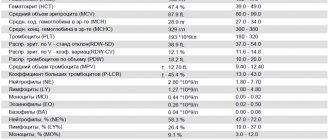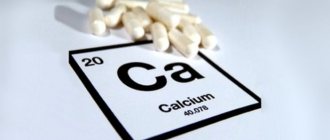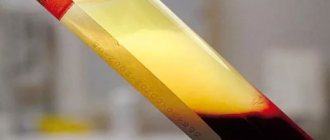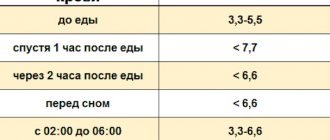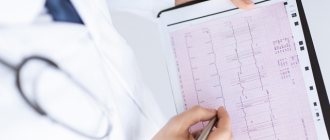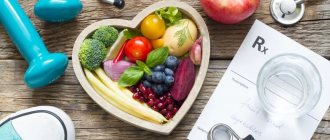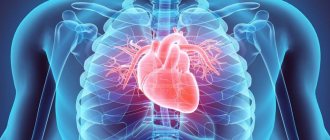Without electrolytes, not a single vital process occurs in the human body. They determine the acid-base balance, maintain osmotic pressure in the blood plasma, and perform other important functions. Without electrolytes, cells will stop interacting, muscles will stop contracting, and nerve fibers will stop transmitting signals. Everything will stop. The balance of sodium, potassium and chlorine is a significant indicator of human health, especially the functioning of the heart and kidneys. Program 116 “Electrolyte balance in the body” allows you to determine the general state of health and diagnose electrolyte metabolism disorders that lead to serious consequences - shock, respiratory and heart failure, arrhythmia and cardiac arrest.
The composition of the program is designed in such a way as to determine the main indicators of electrolyte and acid-base balance:
- Potassium (K+) is clinically important for assessing renal function, the cardiovascular system, diagnosing arrhythmias, hypertension, and adrenal insufficiency.
- Sodium (Na+) reflects the health of the kidneys and adrenal glands.
- Chlorine (Cl-). Used for monitoring and dynamic observation of acid-base balance disorders, diagnosis of kidney diseases, diabetes insipidus.
- Calcium (Ca2+) . Determining its concentration is important in diagnosing patients with chronic renal failure, in determining hyperthyroidism caused by phosphate retention in the body, and also for monitoring treatment results.
- Phosphorus . It is used in the diagnosis of various pathological conditions that cause disturbances in phosphorus-calcium metabolism.
- Blood pH – determination of acid-base balance for the diagnosis of acidosis and alkalosis.
Since electrolyte and acid-base imbalances accompany a wide range of acute and chronic diseases, Program 116 “Electrolyte Balance in the Body” can be prescribed to both patients who are already hospitalized and those who have just presented to emergency departments.
Blood test for electrolytes
Pathologies for which it is necessary to donate blood for electrolytes:
- Exchange disorders
- Prolonged vomiting
- Diarrhea,
- Blood loss
- Burns.
A blood test for electrolytes is carried out to monitor dynamics during the treatment of diseases of the kidneys, liver, heart and blood vessels. If the patient has nausea, vomiting, edema, arrhythmia, hypertension and clouding of consciousness, it is also necessary to determine the amount of anions and cations in the blood.
Children and the elderly are especially sensitive to disturbances in the electrolyte balance in the blood, which is due to defective compensation mechanisms. They do not tolerate well and have difficulty adapting to the changing conditions of the internal environment of the body.
Blood is donated from the ulnar vein in the morning on an empty stomach. Experts recommend not drinking alcohol or smoking, and giving up strong tea and coffee the day before the test. Physical overexertion before the study is also undesirable.
Methods for conducting a biochemical blood test for electrolytes:
- During the chemical transformations occurring in the blood serum, an insoluble precipitate is formed. It is weighed, the formula and composition are determined, and then recalculated into a pure substance.
- The use of standard solutions for color reactions allows one to draw a conclusion about the dissolved substance based on the degree of plasma coloration.
- Express methods using modern laboratory equipment quickly produce results from which a conclusion can be made about the level of electrolytes in the blood.
Only doctors interpret the laboratory results obtained. When the normal content of calcium, potassium and sodium in the blood is disturbed, a water-electrolyte imbalance develops, which is manifested by swelling of the soft tissues, symptoms of dehydration, paresthesia, and convulsive syndrome.
Prevention is the key to health
It is necessary to constantly maintain the balance of salts and fluids in the body, and not resort to replenishing it only when you already feel unwell.
For prevention, engage in light physical activity, monitor proper nutrition and periodically undergo examination by specialists (if there is a slight deviation from the norm, you can resort to medication). For maximum results, you will have to maintain a healthy lifestyle on an ongoing basis.
Stop torturing yourself!
- We will develop a personal nutrition program for you.
- With it you will achieve your ideal weight without fasting or physical activity.
- This is the only truly healthy and natural way to lose weight.
Potassium
Potassium is an electrolyte that ensures that water balance is maintained at an optimal level. This unique element has a stimulating effect on myocardial function and a protective effect on blood vessels.
The main functions of potassium in the body:
- Antihypoxic effect,
- Removal of toxins,
- Increased strength of heart contractions,
- Normalization of heart rate,
- Maintaining optimal functioning of immunocompetent cells,
- Influence on the development of allergies in the body.
This microelement is excreted by the kidneys with urine, the intestines with feces, and the sweat glands with sweat.
A blood test to determine potassium ions is indicated for kidney inflammation, anuria, and arterial hypertension. Normally, the concentration of potassium electrolytes in infants under one year of age is 4.1 – 5.3 mmol/l; in boys and girls - 3.4 - 4.7 mmol/l; in adults - 3.5 - 5.5 mmol/l.
Hyperkalemia (increased potassium levels in the blood) develops when:
- Following starvation diets,
- Convulsive syndrome,
- Hemolysis of red blood cells,
- Dehydration,
- Acidification of the internal environment of the body,
- Adrenal dysfunction,
- Excess of foods containing potassium in the diet
- Long-term therapy with cytostatics and NSAIDs.
With prolonged increases in potassium levels in the blood, patients may develop stomach ulcers or sudden cardiac arrest. To treat hyperkalemia, you should consult a doctor.
The causes of hypokalemia (low potassium in plasma) are:
- Excessive physical activity
- Psycho-emotional stress,
- Alcoholism,
- Excessive consumption of coffee and sweets,
- Taking diuretics
- Diets,
- Massive swelling,
- Dyspepsia,
- Hypoglycemia,
- Cystic fibrosis,
- Hyperhidrosis.
Potassium deficiency in the blood can manifest itself as fatigue, weakness, leg cramps, hyporeflexia, shortness of breath, and cardialgia.
Hypokalemia caused by a lack of intake of the element into the body can be corrected with the help of diet. Topping the list of foods rich in potassium is sweet potatoes. It is baked, fried, boiled, grilled. Fresh tomatoes and tomato paste, beet tops, white beans, lentils, peas, natural yogurt, edible shellfish, dried fruits, carrot juice, molasses, halibut and tuna, pumpkin, bananas, milk are the best sources of potassium.
When you lose beneficial minerals
The causes of loss of electrolytes in the body can be divided into natural and pathological. I will give the most common reasons.
Meager diet
If you eat few vegetables, fruits, greens and nuts, you will constantly face a deficiency of electrolytes. Popular foods such as baked goods, sweets and processed foods contain virtually no minerals.
Sports, hard physical work, heat
To lower body temperature, the body intensively secretes sweat. Sodium and potassium usually leave with the fluid. This is why sports drinks are so popular among those who go to the gym or run.
Lack of fluid
As I wrote above, minerals become electrolytes in the body only in an aqueous solution. If there is little moisture, they only clog the internal organs, especially the kidneys.
Taking medications
The process of mineral absorption can be disrupted by the following drugs: diuretics, NSAIDs, antibiotics. After stopping the course of treatment, the balance of electrolytes in the body is restored.
Tip: drink 1.5–2 liters of water per day and don’t forget about vegetables and fruits. Do not get carried away with laxatives and diuretics.
Pathological causes of electrolyte deficiency are acute and chronic diseases. Thus, food poisoning causes vomiting and diarrhea. Minerals leave along with the liquid, which only aggravates the problem. Therefore, to restore the balance of electrolytes in the body after poisoning, doctors recommend taking a salt preparation, for example, Regidron.
The following diseases often lead to improper absorption of micro and macroelements:
- stomach (gastritis, ulcer);
- kidney;
- endocrine system (especially pathologies of the thyroid gland - thyroiditis, hypothyroidism);
- cystic fibrosis;
- gout;
- dysbacteriosis or intestinal infection with worms.
In such situations, drinking sports drinks and taking dietary supplements is useless. First you need to cure the underlying disease. Then the exchange of electrolytes in the body will gradually return to normal.
Sodium
Sodium is the main extracellular cation, an element that helps the body actively grow and develop. It ensures the transport of nutrients to the cells of the body, participates in the generation of nerve impulses, has an antispasmodic effect, activates digestive enzymes and regulates metabolic processes.
The norm of sodium in the blood for adults is 135 – 150 mmol/l. (For children – 130 – 145 mmol/l).
Sodium leaves the body through sweating. People constantly need it, especially those who experience severe physical activity. You need to constantly replenish your sodium supply. The daily sodium intake is about 550 mg. Plant and animal sources of sodium: table salt, cereals, soy sauce, vegetables, beans, organ meats, seafood, milk, eggs, pickles, sauerkraut.
When the amount of sodium cations in the blood changes, the functioning of the kidneys, nervous system, and blood circulation is disrupted.
A blood test for sodium electrolytes is carried out for gastrointestinal dysfunction, diseases of the excretory system, and endocrine pathologies.
Hypernatremia (increased levels of the element in the blood) develops when:
- Excess salt in the diet,
- Long-term hormone therapy
- Pituitary hyperplasia,
- Adrenal tumors,
- Comatose state
- Endocrinopathies.
The causes of hyponatremia are:
- Refusal of salty foods,
- Dehydration resulting from repeated vomiting or prolonged diarrhea
- Hyperthermia,
- Loading doses of diuretics,
- Hyperglycemia,
- Hyperhidrosis,
- Prolonged shortness of breath
- Hypothyroidism,
- nephrotic syndrome,
- Heart and kidney diseases,
- Polyuria,
- Cirrhosis of the liver.
Hyponatremia is manifested by nausea, vomiting, decreased appetite, palpitations, hypotension, and mental disorders.
How to replenish the water-salt balance with the help of medications?
Water and electrolyte imbalance manifests itself differently in everyone, so the approach to “treatment” must be individual. It is extremely rare that the body lacks all elements at once, so after passing the diagnosis, the specialist prescribes a specific medicine to the patient.
Despite the abundance of choice of dietary supplements in pharmacies and the fact that they are all available without a prescription, you should not self-medicate. I would like to remind you that excess salts in the body leads to the development of various diseases. Don't forget about the side effects.
In addition, in addition to the salts themselves, it is necessary to select preparations for better absorption and accumulation of these elements in the body.
Chlorine
Chlorine is a blood electrolyte, the main anion that normalizes water-salt metabolism “paired” with positively charged cations of sodium and other elements (including potassium). It helps to equalize blood pressure, reduce tissue swelling, activate the digestion process, and improve the functioning of hepatocytes.
The level of chlorine in the blood for adults ranges from 97 to 108 mmol/l. For children of different ages, the range of normal values is slightly wider (From 95 mmol/l for most age groups and up to 110-116 mmol/l. The most chlorine can be contained in the blood of newborns).
An increase in chlorine levels (hyperchloremia) develops when:
- Dehydration,
- Alkalose,
- Kidney pathologies,
- Excessive functioning of the glandular cells of the adrenal glands,
- Vasopressin deficiency in the body.
The causes of hypochloremia are:
- Vomit,
- Hyperhidrosis,
- Treatment with large doses of diuretics,
- TBI,
- Acidotic coma,
- Regular intake of laxatives.
Patients with hypochloremia experience hair and teeth loss.
Table salt, olives, meat, dairy and bakery products are rich in chlorine.
Stock
Antibody test for coronavirus (COVID-19)
from 2000 a
Rapid test for coronavirus (COVID-19)
Results within 25 minutes from the moment the biomaterial is submitted
1600a
Coronavirus (COVID-19) antibody test at home
from 4200 a
Coronavirus (COVID-19) test at home
from 4950 a
Coronavirus (COVID-19) test
2750a
Calcium
Calcium is an electrolyte responsible for the normal functioning of the coagulation and cardiovascular systems, regulation of metabolism, strengthening the nervous system, building and ensuring the strength of bone tissue, and maintaining a stable heart rhythm.
The normal level of calcium in the blood is 2-2.8 mmol/l. Its content does not depend on age and gender characteristics. Determination of calcium in the blood must be carried out in case of rarefaction of bone tissue, bone pain, myalgia, diseases of the gastrointestinal tract, heart, blood vessels, and oncopathology.
Hypercalcemia develops when:
- Hyperfunction of the parathyroid glands,
- Cancerous destruction of bones,
- Thyrotoxicosis,
- Tuberculous inflammation of the spine,
- Kidney pathologies,
- Gout,
- Hyperinsulinemia,
- Excessive intake of vitamin D into the body.
The causes of hypocalcemia are:
- Bone formation disorders in children,
- Bone loss,
- Lack of thyroid hormones in the blood,
- Inflammatory and degenerative processes in the pancreas,
- Magnesium deficiency
- Violation of the bile excretion process,
- Liver and kidney dysfunction,
- Long-term use of cytostatics and antiepileptic drugs,
- Cachexia.
The following foods are sources of calcium: milk, white beans, canned tuna, sardines, dried figs, cabbage, almonds, oranges, sesame seeds, seaweed. Sorrel, chocolate, spinach are foods with an antagonistic effect that suppress the effect of calcium. This microelement is absorbed only in the presence of an optimal amount of vitamin D.
Magnesium
Magnesium is a vital electrolyte that works alone or in conjunction with other cations: potassium and calcium. It normalizes myocardial contraction and improves brain function. Magnesium prevents the development of calculous cholecystitis and urolithiasis. It is taken to prevent stress and cardiac dysfunction.
distribution of magnesium ions in the body
The generally accepted norm of magnesium in the blood is 0.65-1 mmol/l. Determination of the amount of magnesium cations in the blood is carried out for patients with neurological disorders, kidney diseases, endocrine pathologies, and rhythm disturbances.
Hypermagnesemia develops when:
- Insufficient amount of thyroid hormones in the blood,
- Pathologies of the kidneys and adrenal glands,
- Dehydration,
- Long-term and uncontrolled use of magnesium-containing drugs.
The causes of hypomagnesemia are:
- Starvation diets,
- Colitis,
- Worms,
- Pancreatitis,
- Thyrotoxicosis,
- Rickets,
- Hereditary phosphorus deficiency,
- Hypercalcemia,
- Alcoholism.
Some foods are sources of magnesium - oatmeal, bran bread, pumpkin seeds, nuts, fish, bananas, cocoa, sesame seeds, potatoes. The absorption of magnesium is impaired by the abuse of alcoholic beverages, frequent use of diuretics, and hormonal drugs.
Iron
Iron is an electrolyte that ensures the transport and delivery of oxygen to cellular elements and tissues. As a result, the blood is saturated with oxygen, the process of cellular respiration and the formation of red blood cells in the bone marrow are normalized.
Iron enters the body from the outside, is absorbed in the intestines and spreads through the bloodstream throughout the body. Sources of iron are: bran bread, shrimp, crab meat, beef liver, cocoa, egg yolk, sesame seed.
Iron in the body of newborns and children up to one year old varies between 7.16 - 17.90 µmol/l, in children from one to 14 years of age - 8.95 - 21.48 µmol/l, in adults - 8.95 - 30, 43 µmol/l.
People with iron deficiency develop iron deficiency anemia, the immune defense and general resistance of the body decrease, fatigue increases, and fatigue quickly occurs. The skin becomes pale and dry, muscle tone decreases, the digestion process is disrupted, and appetite disappears. Characteristic changes are also noted in the cardiovascular and bronchopulmonary systems: increased heart rate, difficulty breathing, shortness of breath. In children, the processes of growth and development are disrupted.
Women need iron more than men. This is due to the loss of a certain part of the element during monthly bleeding. During pregnancy, this is especially important, since two organisms need iron at once - the mother and the fetus. Special medications will help future mothers and nursing women prevent iron deficiency in the body - “Hemofer”, “Sorbifer”, “Maltofer Fol”, “Heferol” (all drugs are prescribed by a doctor!)
Iron electrolytes in the blood are increased with:
- Hemochromatosis,
- Hypo- and aplastic anemia,
- B12-, B6- and folate deficiency anemia,
- Violation of hemoglobin synthesis,
- Inflammation of the glomeruli of the kidneys,
- Hematological pathologies,
- Lead intoxication.
The causes of blood iron deficiency are:
- Iron-deficiency anemia,
- Lack of vitamins
- Infections,
- Oncopathology,
- Massive blood loss
- Gastrointestinal dysfunctions,
- Taking NSAIDs and glucocorticosteroids,
- Psycho-emotional stress.

